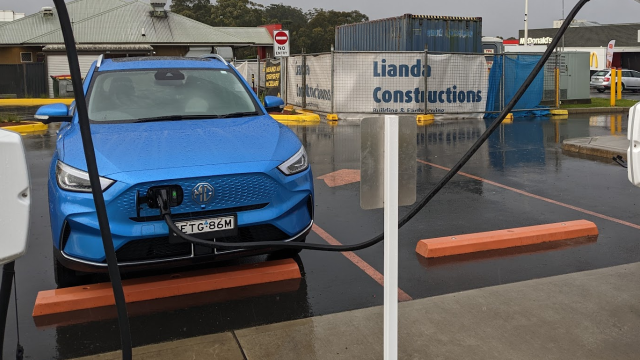There are a handful of electric vehicle misconceptions that tend to float about – that they don’t have much range, that they take hours to charge, or that they are somehow worse for the environment are commonly tossed about as arguments against switching to an electric car, but a question that tends to come up less often is “can you charge an EV in the rain?” – likely because it’s extremely easy to answer.
Yes.
Let’s not leave the article there as it’s a bit simple and not particularly helpful. Chris and Julie Ramsey, the couple currently driving a modified Nissan Ariya from the North Pole to the South Pole (in an attempt for it to be the first EV to do so), put up a tweet of the car recharging at a station in Costa Rica – while heavy rain drenched the car.
“Thought we would just put a final nail in the coffin of ‘you can’t charge an EV in the rain’ comments we still here,” the team wrote.
It’s a fairly similar charging station to what Aussies might be used to – an exposed bowser-like box, sticking out of the ground with either one or two charging cables, with one usually fitted with a CHAdeMO plug (the Japanese standard seen on the Nissan Leaf in Australia) and a Type 2/CCS2 plug (used by almost every other EV in Australia).
Unlike many Australian chargers, however, the charging station is undercover, so rain can’t drench it so easily. I’ve personally tried to use an EV charger during quite wet weather, with machines out of order, long queues, and a slow-charging battery, and at the very least, it’d be nice if Australian chargers had a roof over them.
But never mind that; EV charging stations are designed so that they won’t be taken offline during the rain – they can withstand the weather, and you can still use them, even during a Monsoon, as seen above. The cables that run between the station and the car are heavily insulated, and charging plugs are typically IP-rated.
And if that’s not good enough for you, according to Hertz:
“EVs are safe to charge in all weather conditions. From the cables to the chargers and charging points, every piece of equipment has not only been waterproofed but rigorously tested.”
“What happens if you charge an electric car in the rain and water breaches the waterproofing? Well, nothing. There are several safety measures to protect you. If water gets into an EV charger, the connection will be interrupted and the current won’t flow. So you and any passengers are completely safe.”
It’s safe – but the charging experience sure could be better, and of course, weather conditions impact EV range.
Want more Aussie car news? Here’s every EV we’ve reviewed in the last two years, all the EVs we can expect down under soon, and our guide to finding EV chargers across the country. Check out our dedicated Cars tab for more.
